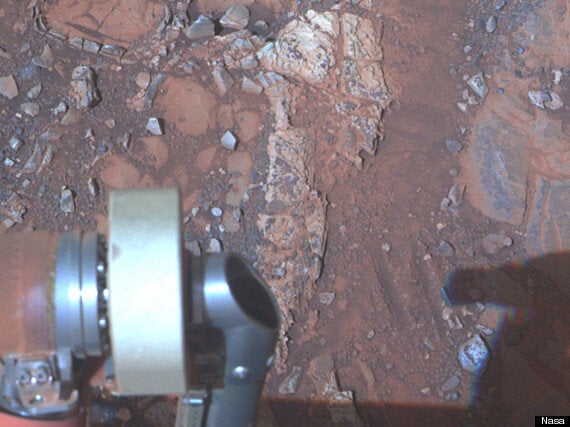The ageing Mars rover Opportunity has found evidence that the conditions for ancient life once existed on the Red planet.
The six-wheeled robot has been on Mars since 2004, but it is still producing useful science.
Its remarkable longevity has astounded and delighted Nasa officials, who initially expected that it would last for just 90 Martian days.
Instead it is continuing to roll along the surface, 37 times longer than anybody thought it would.
Its latest discovery is one of its most exciting, Nasa officials said: an area of rock which was clearly weathered by large amounts of water, indicating that the conditions for life once existed on the planet.

Above: Preliminary interpretation points to clay mineral content due to intensive alteration by water.
No, it's not quite a skeleton of a Martian buffalo. But the rock ("Esperance") is unlike any the rover has previously found, fractured and weathered by conditions that were "possibly favorable for life", Nasa said.
The new pictures were taken at Cape York, an area on the rim of the massive Endeavour crater.
"What's so special about Esperance is that there was enough water not only for reactions that produced clay minerals, but also enough to flush out ions set loose by those reactions, so that Opportunity can clearly see the alteration," said Scott McLennan of the State University of New York.
Lead investigator Steve Squyres said that the "water that moved through fractures during this rock's history would have provided more favourable conditions for biology than any other wet environment recorded in rocks".
The new evidence supports the discovery earlier this year by Nasa's one-ton robot Curiosity rover, which landed on the planet only last year but has already shown that the planet could have supported microbial life in the past.
Opportunity had been exploring Cape York for about 20 months, but it is now heading to another area known as Solander Point, where it will spend the Martian winter.
On the way the rover will break the international record for longest distance travelled on another world, currently held by the Russian Moon robot Lunokhod 2 at 23 miles.
Among its other finds, Opportunity recently discovered a series of metal spheres on the planet.
CORRECTION: The headline of this article originally stated the Mars rover had discovered evidence for ancient life on Mars. The rover actually discovered evidence of conditions that could once have supported life on Mars.